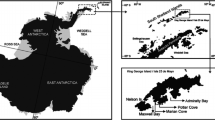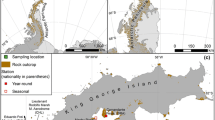Abstract
Phenol degradation efficiency of cold-tolerant Arthrobacter sp. AG31 and mesophilic Pseudomonas putida DSM6414 was compared. The cold-tolerant strain was cultivated at 10°C, while the mesophile was grown at 25°C. Both strains degraded 200 mg and 400 mg phenol/l within 48–72 h of cultivation, but the cold-tolerant strain produced more biomass than the mesophile. Both strains oxidized catechol by the ortho type of ring fission. Catechol 1,2 dioxygenase (C1,2D) activity was found intra- and extracellularly in the absence and in the presence of phenol. In the presence of 200 mg phenol/l, C1,2D activity of the mesophile was about 1.5- to 2-fold higher than that of the cold-tolerant strain. However, an initial phenol concentration of 400 mg/l resulted in a comparable enzyme activity of the cold-tolerant and the mesophilic strain. The two strains differed significantly in their toxicity pattern towards 12 aromatic (mostly phenolic) compounds at different growth temperatures, which was determined via growth inhibition in the presence of nutrients and toxicants. For the cold-tolerant strain, toxicity was significantly lower at 10°C than at 25°C. The mesophile showed a significantly lower susceptibility to high hydrocarbon concentrations when grown at 25°C compared to 10°C.




Similar content being viewed by others
References
Allsop PJ, Christy Y, Moo-Young M, Sullivan GR (1992) Dynamics of phenol degradation by Pseudomonas putida. Biotechnol Bioeng 41:572–580
Bastos AER, Moon DH, Rossi A, Trevors J, Tsai SM (2000a) Salt-tolerant, phenol-degrading microorganisms isolated from Amazonian soil samples. Arch Microbiol 174:346–352
Bastos AER, Tornisielo VL, Nozawa SR, Trevors JT, Rossi A (2000b) Phenol metabolism by two microorganisms isolated from Amazonian forest soil samples. J Ind Microbiol Biotechnol 24:403–409
Birger A, Krauß G, Kiesel B, Dermietzel J, Gläßer W (1997) Abbaupotential für aliphatische und aromatische Kohlenwasserstoffe in bakteriellen und heterotrophen Communities differenter Grundwasser-Biozönosen. In: Kreysa G, Wiesner J (eds) Möglichkeiten und Grenzen der Reinigung kontaminierter Gewässer. Dechema, Frankfurt a M, pp 571–581
Feitkenhauer H, Schnicke S, Müller R, Märkl H (2001) Determination of the kinetic parameters of the phenol-degrading thermophile Bacillus thermoleovorans sp. A2. Appl Microbiol Biotechnol 57:744–750
Fritsche W (1998) Umwelt-Mikrobiologie. Gustav Fischer, Jena
Gibson DT, Gschwendt B, Keh W, Kobal VM (1973) Initial reactions in the oxidation of ethylbenzene by Pseudomonas putida. Biochemistry 12:1520–1528
Gurujeyalakshmi G, Oriel P (1989) Isdoation of phenol-metabolizing enzymes in Trichosporon cutaneum. Arch Microbiol 130:54–58
Hamzah RY, Al-Baharna BS (1994) Catechol ring cleavage in Pseudomonas cepacia: the simultaneous induction of ortho and meta pathways. Appl Microbiol Biotechnol 41:250–256
Hinteregger C, Streichsbier F (1997) Halomonas sp., a moderately halophilic strain, for biotreatment of saline phenolic waste water. Biotechnol Lett 19:1099–1102
Hinteregger C, Leitner R, Loidl M, Ferschl A, Streichsbier F (1992) Degradation of phenol and phenolic compounds by Pseudomonas putida EFII. Appl Microbiol Biotechnol 37:252–259
Keddie RM, Collins MD, Jones D (1986) Genus Arthrobacter. In: Sneath PH, Mair NS, Sharpe NE, Holt JG (eds) Bergey’s manual of systematic bacteriology, vol 2. Wiliams and Wilkins, Baltimore, pp 1288–1301
Kotturi G, Robinson CW, Inniss WE (1991) Phenol degradation by a psychrotrophic strain of Pseudomonas putida. Appl Microbiol Biotechnol 34:539–543
Lengeler JW, Drews G, Schlegel HG (eds) (1999) Biology of the prokaryotes. Thieme, Stuttgart
Li JK, Humphrey AE (1989) Kinetic and fluorimetric behaviour of a phenol fermentation. Biotechnol Lett 11:177–182
Margesin R, Schinner F (2001) Biodegradation and bioremediation of hydrocarbons in extreme environments. Appl Microbiol Biotechnol 56:650–663
Margesin R, Schinner F (2003) Phenol degradation by cold-tolerant bacteria and yeasts. In: Proceedings of the Second European Bioremediation Conference. Chania, Greece, pp 200–203
Margesin R, Feller G, Gerday C, Russell NJ (2002) Cold-adapted microorganisms: adaptation strategies and biotechnological potential. In: Bitton G (ed) The encyclopedia of environmental microbiology, vol 2. Wiley, New York, pp 871–885
Margesin R, Gander S, Zacke G, Gounot AM, Schinner F (2003) Hydrocarbon degradation by cold-tolerant bacteria and yeasts. Extremophiles 7:451–458
Morita RY (1975) Psychrophilic bacteria. Bacteriol Rev 39:144–167
Müller RH, Babel W (1994) Phenol and its derivatives as heterotrophic substrates for microbial growth—an energetic comparison. Appl Microbiol Biotechnol 42:446–451
Mutzel A, Reinscheid UM, Antranikian G, Müller R (1996) Isolation and characterization of a thermophilic Bacillus strain that degrades phenol and cresols as sole carbon source at 70°C. Appl Microbiol Biotechnol 46:593–596
Nakazawa T, Nakazawa A (1970) Pyrocatechase (Pseudomonas). In: Colowick SP, Kaplan NO (eds) Methods in enzymology, vol 17A. Academic, New York, pp 518–522
Nakazawa T, Yokota T (1973) Benzoate metabolism in Pseudomonas putida (arvilla) mt-2: demonstration of two benzaote pathways. J Bacteriol 115:262–267
Natarajan MR, Lu Z, Oriel P (1994) Cloning and expression of a pathway for benzene and toluene from Bacillus stearothermophilus. Biodegradation 5:77–82
Nozaki M (1970) Metapyrocatechase (Pseudomonas). In: Colowick SP, Kaplan NO (eds) Methods in enzymology, vol 17A. Academic, New York, pp 522–525
Ren S, Frymier PD (2003) Toxicity estimation of phenolic compounds by bioluminescent bacterium. J Environ Eng-ASCE 129:328–335
Santos VL, Linardi VR (2001) Phenol degradation by yeasts isolated from industrial effluents. J Gen Appl Microbiol 47:213–221
Verharr HJM, Van Leeuwen CJ, Hermens JLM (1992) Classifying environmental pollutants. 1: Structure-activity relationship for prediciton of aquatic toxicity. Chemosphere 25:471–491
Author information
Authors and Affiliations
Corresponding author
Additional information
Communicated by K. Horikoshi
Rights and permissions
About this article
Cite this article
Margesin, R., Bergauer, P. & Gander, S. Degradation of phenol and toxicity of phenolic compounds: a comparison of cold-tolerant Arthrobacter sp. and mesophilic Pseudomonas putida . Extremophiles 8, 201–207 (2004). https://doi.org/10.1007/s00792-004-0378-3
Received:
Accepted:
Published:
Issue Date:
DOI: https://doi.org/10.1007/s00792-004-0378-3




